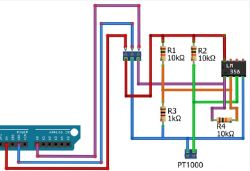FAQ
TL;DR: Need lights that turn on when you walk in and off when you leave? Use a doorway people counter with two IR barriers; "As long as the number of people > 0 the light will stay on." It works even with shelves blocking view. [Elektroda, Anonymous, post #19514276]
Why it matters: Hands-free lighting that doesn’t leave you in the dark, even with open entries or obstructed sightlines, for DIYers and facility managers alike.
Quick Facts
- Presence sensors (e.g., STEINEL IR Quattro HD, KANLUX SENTO) detect micro‑movements and outperform basic PIR in quiet rooms; select by room geometry [Elektroda, Mobali, post #19513620]
- Two-beam IR doorway counters raise or lower a people count and keep lights on while count > 0 [Elektroda, Anonymous, post #19514276]
- Reed-switch door contacts need an actual door and aren’t suitable for open entries [Elektroda, adwlodar, post #19513613]
- Use aisle or multiple sensors to cover shelf aisles; prefer long, narrow fields of view [Elektroda, adwlodar, post #19516318]
- Off‑the‑shelf kits exist (e.g., AVT3014) that implement beam-counting control without coding [Elektroda, nikusert, post #19516370]
What’s the best solution if my room has no door and shelves create blind spots?
Use multiple sensors positioned per aisle, or dedicated aisle sensors with narrow, long coverage. This mirrors warehouse layouts. A single photo barrier plus a bistable relay also fits open entries. However, mismatched entry/exit counts can leave someone inside without light. [Elektroda, adwlodar, post #19516318]
Will a standard PIR work, or do I need a presence sensor?
Standard PIR can miss small movements and switch lights off. Presence sensors detect micro‑movements and offer higher precision. Place them where they see occupants despite limited motion. “Also detecting micro-movements of the object.” Example models mentioned: STEINEL IR Quattro HD and KANLUX SENTO. [Elektroda, Mobali, post #19513620]
How do I deal with bookshelves that block the sensor’s view?
Cover each aisle with a sensor, or use aisle sensors designed for long, narrow fields. Correct positioning and adequate sensor count are critical. This mirrors proven layouts in larger storage spaces. Adjust placement to eliminate shadowed zones behind shelving. [Elektroda, adwlodar, post #19516318]
Can I build a reliable entry/exit counter to control the light?
Yes. Install two IR barriers one behind the other in the doorway. Use activation order to increment on entry and decrement on exit. Keep the light on while the people count is greater than zero. “As long as the number of people > 0 the light will stay on.” [Elektroda, Anonymous, post #19514276]
What if I want no time delay after exit?
Typical motion sensors impose a time delay. If you need immediate off, use a photo beam with a bistable relay. Note the failure case: if different numbers enter and leave, someone may remain inside with lights off. [Elektroda, adwlodar, post #19513613]
How do I prevent the light from switching off while I’m still inside?
Avoid basic PIR in low‑movement scenarios. Use presence sensors, which detect micro‑movements and avoid premature off events. As one expert noted, ordinary PIR can switch off “despite the presence of a person in the room.” Place detectors strategically for full coverage. [Elektroda, Mobali, post #19514536]
Can a microwave sensor help behind shelves or partitions?
Yes. Try a microwave detector, or add more detectors to cover the right areas. Microwave sensors can be less dependent on line‑of‑sight compared with PIR. Combine with proper placement to eliminate dead zones. [Elektroda, misiek1111, post #19515971]
Are there off‑the‑shelf kits for the two‑beam approach?
Yes. An example shared in the thread is AVT3014, an automatic lighting controller. It implements entry/exit beam logic without custom firmware. Use it to drive a lighting relay based on the live people count. [Elektroda, nikusert, post #19516370]
Do reed switches work without doors?
No. Reed-contact approaches assume a door and stable open/close states. They don’t suit open entries, and they can also misbehave if the door must remain open. Choose sensors or beam solutions instead. [Elektroda, adwlodar, post #19513613]
How many sensors might I need in an irregular, aisle‑like room?
It depends on geometry. Start with one sensor per aisle and adjust for coverage. Use aisle sensors if runs are long and narrow. Correct positioning and the right number of detectors achieve reliable presence detection. [Elektroda, adwlodar, post #19516318]
Is a device named LUNO7 a good fit here?
The thread only notes the LUNO7 name and asks for user feedback. No evaluations or experiences were posted. Check its specs and detection pattern against your room layout before buying. [Elektroda, makar42, post #19695808]
Which presence sensor brands were suggested in the thread?
STEINEL IR Quattro HD and KANLUX SENTO were cited as examples. These are presence‑grade detectors that sense micro‑movements. Select devices according to room size, shape, and the optimal mounting points. [Elektroda, Mobali, post #19513620]
Can I combine multiple detection methods for fail‑safe control?
Yes. You can combine motion, presence, beam, and contact methods into one scheme. This boosts reliability and reduces single‑point failures. The thread even suggests using them “all… at the same time.” [Elektroda, adwlodar, post #19513613]
What’s a quick 3‑step plan to set up a two‑beam counter for lights?
- Mount two IR barriers in the doorway, one behind the other.
- Detect beam order to increment on entry or decrement on exit.
- Drive a lighting relay while the people counter is greater than zero. [Elektroda, Anonymous, post #19514276]
What details should I share when asking for help on this problem?
Describe room dimensions, door presence, shelving layout, and desired on/off behavior. Share constraints like no time delay. As one expert put it, the problem is “best described precisely at the beginning.” This speeds accurate recommendations. [Elektroda, Mobali, post #19517013]







